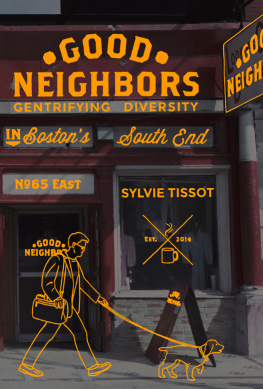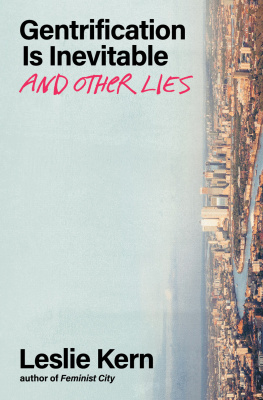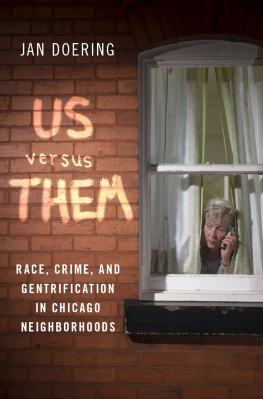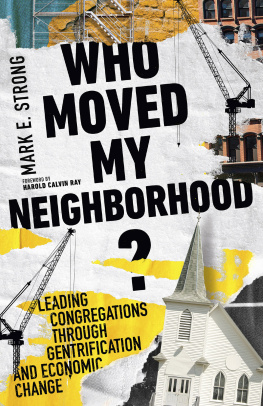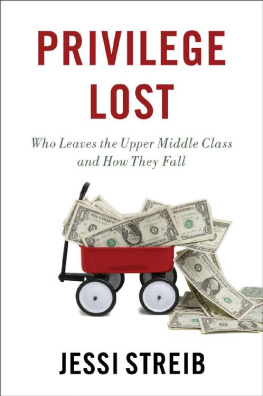Gentrifying Diversity in Bostons South End
Sylvie Tissot
Translated by David Broder
with Catherine Romatowski

This edition first published by Verso 2015
Translation David Broder, Catherine Romatowski 2015
First published as De bons voisins: Enqute dans un quartier de la bourgeoisie progressiste
ditions Raisons dAgir, Paris, 2011
All rights reserved
The moral rights of the author have been asserted
1 3 5 7 9 10 8 6 4 2
Verso
UK: 6 Meard Street, London W1F 0EG
US: 20 Jay Street, Suite 1010, Brooklyn, NY 11201
www.versobooks.com
Verso is the imprint of New Left Books
ISBN-13: 978-1-78168-792-5 (HC)
eISBN-13: 978-1-78168-949-3 (US)
eISBN-13: 978-1-78168-950-9 (UK)
British Library Cataloguing in Publication Data
A catalogue record for this book is available from the British Library
Library of Congress Cataloging-in-Publication Data
Tissot, Sylvie.
[De bons voisins. English]
Good neighbors : gentrifying diversity in Bostons South End / Sylvie Tissot ; translated by David Broder.
pages cm
First published as De bons voisins: Enqu?te dans un quartier de la bourgeoisie progressiste, Editions Raisons dAgir, Paris, 2011.
Includes bibliographical references and index.
ISBN 978-1-78168-792-5 (alk. paper : hbk) ISBN 978-1-78168-949-3 (ebk.) ISBN 978-1-78168-950-9 (ebk.)
1. Middle classMassachusettsBostonAttitudes. 2. GentrificationMassachusettsBoston. 3. Cultural pluralismMassachusettsBoston. 4. Cultural fusionMassachusettsBoston. 5. Sociology, UrbanMassachusettsBoson. 6. NeighborhoodsSocial aspectsMassachusettsBoston. 7. South End (Boston, Mass.)Social conditions. 8. Boston (Mass.)Social conditions. I. Title.
HN80.B7.T5713 2015
305.550974461dc23
2015004601
Typeset in Electra by Hewer Text UK Ltd, Edinburgh, Scotland
Printed in the US by Maple Press
CONTENTS
Landlords are the real terrorists.
After scribbling these angry words across his storefront window, the manager of the Life Caf at New Yorks Tompkins Square Park slid his keys under the door. Confronted with a steep rise in rent, he had decided to close up for good. This was September 2011, a decade after the World Trade Center attacks. The Life Caf was situated in Manhattans East Village, a neighborhood that had seen accelerated gentrification over the last twenty years. Rising rent, population turnover, the restoration of old apartments and the construction of new housing aimed at high-income professionals: this already-familiar story today extends across New York to Brooklyn, as well as neighborhoods in the eastern parts of London, Paris and Berlin. The words of the Life Caf manager, which I happened across in 2011, seemed to bring together all of todays symbols of evil: terrorists and landlords, Al Qaeda and hipsters, bombs and bulldozers. Of course gentrification does not mobilize the same energy at the highest levels of government, nor does local policy make a real attempt to curb it, but gentrification is nevertheless the object of ever more numerous critiques. And in large part for good reasonsones that the East Villages anti-gentrification movements already understood in 1988, before the police evacuated the occupants of Tompkins Square Park.
Gentrification, the rehabilitation of old and degraded neighborhoods as wealthier households move in, is one of the more flagrant manifestations of the inequalities that mark the early twenty-first century. The phenomenon can hardly go unnoticed: it affects more and more cities, from New York and San Francisco to the capitals of Europe and now South America, as changing lifestyles and the transformation of commerce brutally reorganize public space. Racial minorities and the working class today are relegated ever further into the periphery or, for the very poorest, into the insalubrious interstices of the city. But if concern for this phenomenon is mounting, its also because part of the middle class, spending an ever-greater portion of its income on housing, is no longer spared from these pressures. The slogan the right to the city seems more timely than ever more in the planets great conurbations.
The arrival of rich homeowners suddenly attracted to long-stigmatized neighborhoods recently roused the anger of the famous director Spike Lee, who grew up in Fort Greene, then a working-class neighborhood in Brooklyn. Incensed by a New York Times piece invoking the purportedly positive aspects of gentrification, Lee questioned why improvements of schools, policing and trash collection took place only when white people moved into neighborhoods where the black population had long been deprived of quality services. He also castigated the lack of respect shown by new homeowners claiming to have discovered the neighborhood. Like many who have seen the streets where they grew up transformed in recent years, his anger was fed by often unexpected changes, such as the parade of chic dogs, those emblems of gentrification, in Fort Greene Park, or the new names designed to wash away a neighborhoods ghetto reputation, as when Washington, DC real estate agents rechristened LeDroit Park with the more elegant Bloomingdale.
As a consequence, many artists and minorities lament living in cities where alternative counter-cultures and spaces of resistance no longer have any right to that city. Who today can afford to live in Manhattans SoHo or even the Castro in San Francisco? If fashionable galleries prosper, where do artists and writers have to go to find a decent place to live, where they can write and create? When gay neighborhoods see an influx of ever-wealthier heterosexual families, how can gay and lesbian people maintain protected spaces in societies that remain heteronormative? To be sure, the renewal of these areas no longer takes place to the rhythm of bulldozers and riot police batons, but eviction of tenants asked to leave their homes to give free rein to real estate speculation has not stopped.
Even if we ought to be pleased that criticism of gentrification is multiplying, it remains the case that discussion of the phenomenon mostly takes the form of irony. The figure of the hipster is known to all, and blogs post endless, more-or-less humorous comments on the hipsters habits, the variety of coffee he prefers and the length of his beard. The residents who look on, stunned or incredulous, as these hipsters move in next door to them get rather less attention, particularly from journalists, who rarely see rising rent as worth covering. When it comes to gentrification, websites and magazines seem to see gentrification as a kind of board game, where players may choose from several different familial roles: the grandmother (the empty nester rescued from the residential suburbs once her children leave for college); the father (the wealthy banker who owns a brownstone); the mother (the stay-at-home mom pushing her stroller endlessly between the sandbox and the neighborhood cafs); the gay uncle. Or equally, the cousin hipster on his bike, plaid shirt and moustache waving in the wind. Not to forget the baby or babies nestled in the stroller, between the caf and the aisles of Whole Foods. And, of course, the dogthe poodle, the Labrador or the chihuahua. When one speaks of gentrification, the black family, the butch lesbian and the Hispanic worker are always absent.
The denunciation of the hipster (in France called the bobo, bourgeois-bohemian) is all the more unsatisfying for in reality it is always a way of saying that one is not, or not completely, like them. This means of distinguishing oneself betrays a sense of culpability among those who, in looking for housing, must move to ever-poorer, more remote neighborhoods, and in doing so, often unwittingly contribute to transforming these areas. Whether irony or guilt, these sentiments offer few tools for understanding, and ultimately intervening in the urban changes that are taking place.

